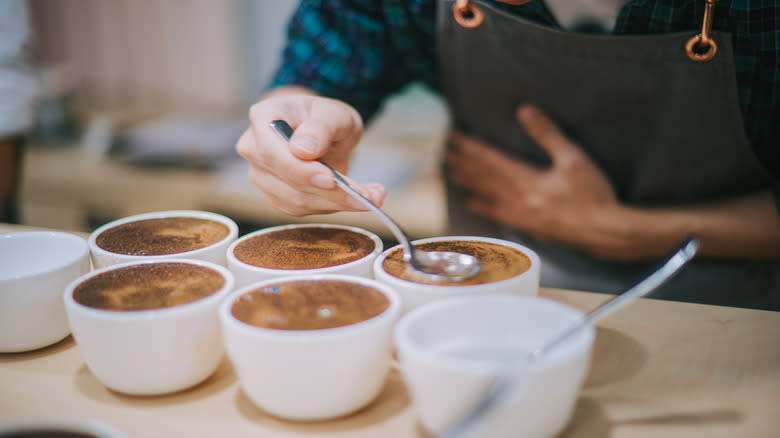Forget Wine, Here's Why You Should Plan A Coffee Tasting Experience

If you think wine tasting is an intensive, immersive experience, get ready for its hot-liquid counterpart: coffee tasting. This isn't simply trying a new Starbucks roast from time to time or ordering a macchiato rather than a latte. Coffee tasting, and the related coffee cupping, involves small cups of concentrated coffee lined up according to varying themes. They can include groupings by country of origin, bean type, roasting style, and more. The goal is to distinguish coffees based on characteristics and to identify your own personal preferences.
First, it's important to note that coffee tasting and coffee cupping are not the same thing. Though related and often used as interchangeable terms, they focus on different things. Coffee cupping is typically an industry practice, with industry-set rules for gauging the quality and flavor profile of coffee beans. It uses the most basic of all preparations: hot water and roasted beans. The process results in cupping scores that classify the beans for market value and price.
Coffee tasting, on the other hand, engages anyone who loves the nuances and intricacies of coffee. The focus is less on the overall quality of the bean for sales purposes and more on how it tastes in the cup. As such, coffee tastings zero in on comparing flavor, aroma, and coffee profiles, which are the basic factors determined during roasting. Tasters are looking for things like fruity, acidic, bitter, nutty, or even chocolatey coffee notes.
Read more: 31 Coffee Brands, Ranked From Worst To Best
Navigating The Coffee Tasting Experience

Coffee tastings, also known as "casual cuppings," are available through special events at indie coffee shops and also at coffee roasting facilities that are open to the public. Smaller venues may offer it at no charge as a way of introducing customers to the various beans or even to coffee farmers who may attend the event. More elaborate versions take place for a fee at one of the six Starbucks Reserve Roasteries. It's offered in the company's Coffee Lab in what's called "A Journey of the Senses," which takes place on most days in the Seattle location by pre-arranged reservations. Virtual tastings from coffee roasters are an excellent alternative.
Formal coffee tastings offer considerable value since guides help distinguish flavors, characteristics, and profiles. A basic format for a guided tasting can include the "sniff, slurp, locate, and describe" progression. Each person notes their perceptions and writes them down, then compares them with others tasting identical cups of coffee prepared at the same time.
First up is to smell just as you would foods, noting aromas such as spicy, sweet, nutty, bitter, or smoky. Slurping is the next crucial step because it scatters the coffee taste across all of the tongue's receptors. To locate, also called evaluating, means paying attention to the liquid's consistency and where the flavors land on the tongue. Finally, you'll learn how to describe all that you've identified and form a preference based on the fab four: flavor, body, aroma, and acidity.
Read the original article on Tasting Table.

